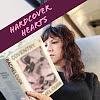Take a photo of a barcode or cover

hardcoverhearts 's review for:
Christodora
by Tim Murphy
I certainly was the target demographic for this book. Having grown up in the timeframe the book primarily takes place in, having loved NYC as an East Coaster and having lost family members and loved ones to AIDS, this book had the potential to crush me. I was actually a little nervous to start it because I was worried it would be emotionally devastating, a la A Little Life, by Hanya Yanagihara. I went in bracing myself, but instead it was a complex character study of a family, their friends and offspring with NYC and the AIDS crisis as both backdrop and purpose for bringing a good number of the characters together.
I really fell in with these characters. I didn't love them all. Some were quite frustrating in their obstinance or inability to see outside themselves. Those flaws gave the story layers and complexity. I liked the passion and that some of them didn't reach redemption or clarity. And I appreciated that there wasn't a tidy bow at the end, though there was enough that brought the book to a logical ending.
My only complaint, as it were, was that I wasn't in love with how the timeline moved. At points in the story, it felt too jarring a leap to make in time, or we just started to follow random names for no discernible reason. I also felt that some of the pop culture references were sprinkled in too liberally and may feel very awkward in a decade.
But even with those challenges, I still would give the book a 3.5-4. I think it is a very good book for someone who may want a character study of NYC during the AIDS Crisis and from outside the traditional gay lens, though with important gay characters. It would be a good accompaniment to the masterwork of the subject- Randy Shilts' nonfiction reportage, And The Band Played On. And for another, very different look at NYC in that time, the new Netflix TV series The Get Down which documents in vibrancy the birth of hip hop and graffiti culture in NYC.
I really fell in with these characters. I didn't love them all. Some were quite frustrating in their obstinance or inability to see outside themselves. Those flaws gave the story layers and complexity. I liked the passion and that some of them didn't reach redemption or clarity. And I appreciated that there wasn't a tidy bow at the end, though there was enough that brought the book to a logical ending.
My only complaint, as it were, was that I wasn't in love with how the timeline moved. At points in the story, it felt too jarring a leap to make in time, or we just started to follow random names for no discernible reason. I also felt that some of the pop culture references were sprinkled in too liberally and may feel very awkward in a decade.
But even with those challenges, I still would give the book a 3.5-4. I think it is a very good book for someone who may want a character study of NYC during the AIDS Crisis and from outside the traditional gay lens, though with important gay characters. It would be a good accompaniment to the masterwork of the subject- Randy Shilts' nonfiction reportage, And The Band Played On. And for another, very different look at NYC in that time, the new Netflix TV series The Get Down which documents in vibrancy the birth of hip hop and graffiti culture in NYC.